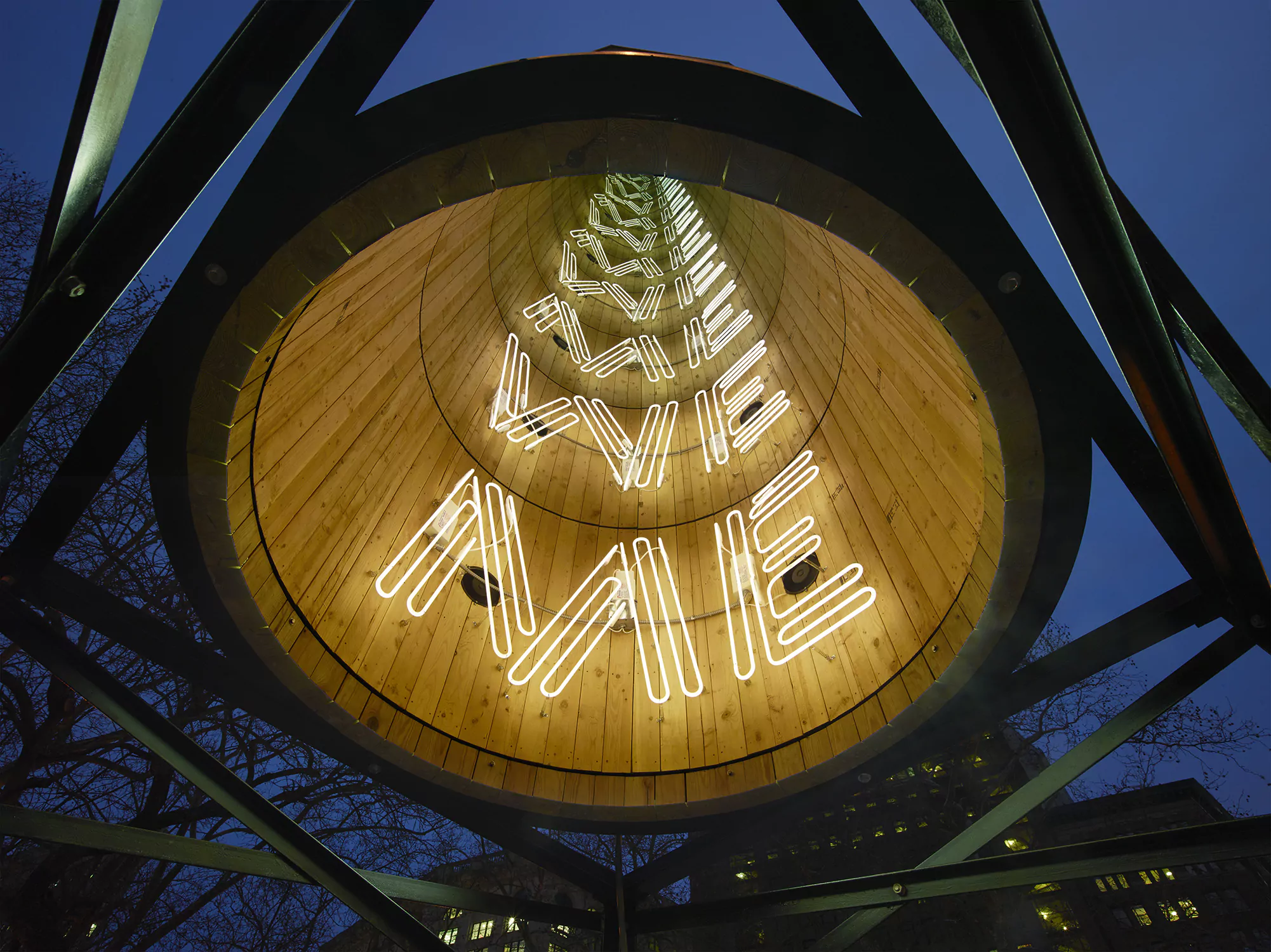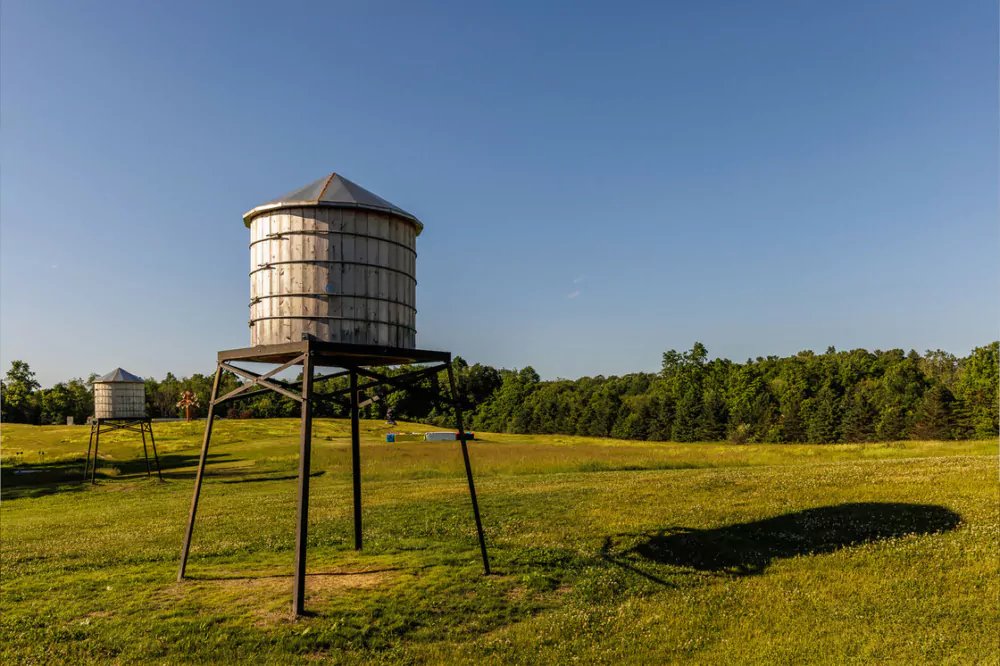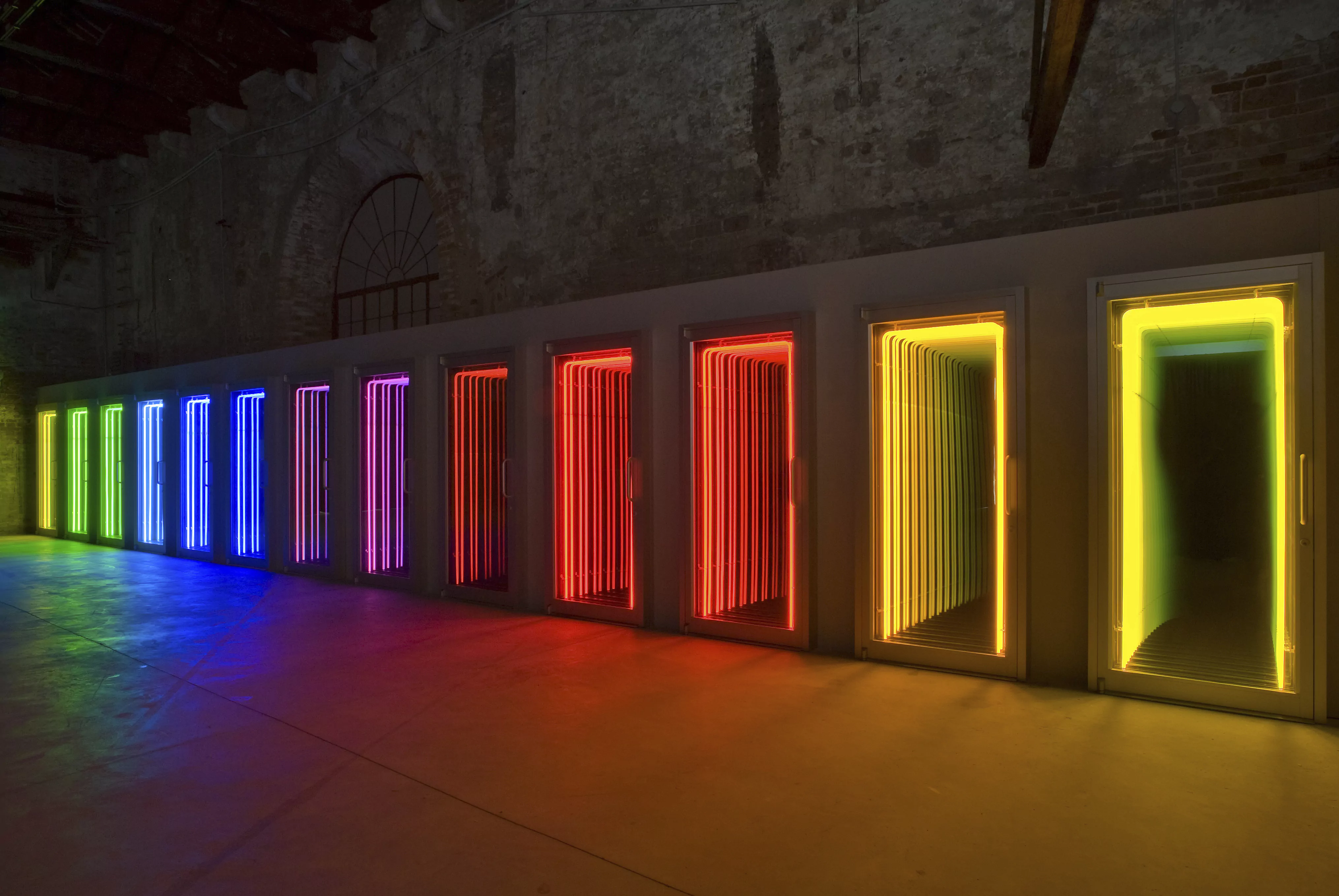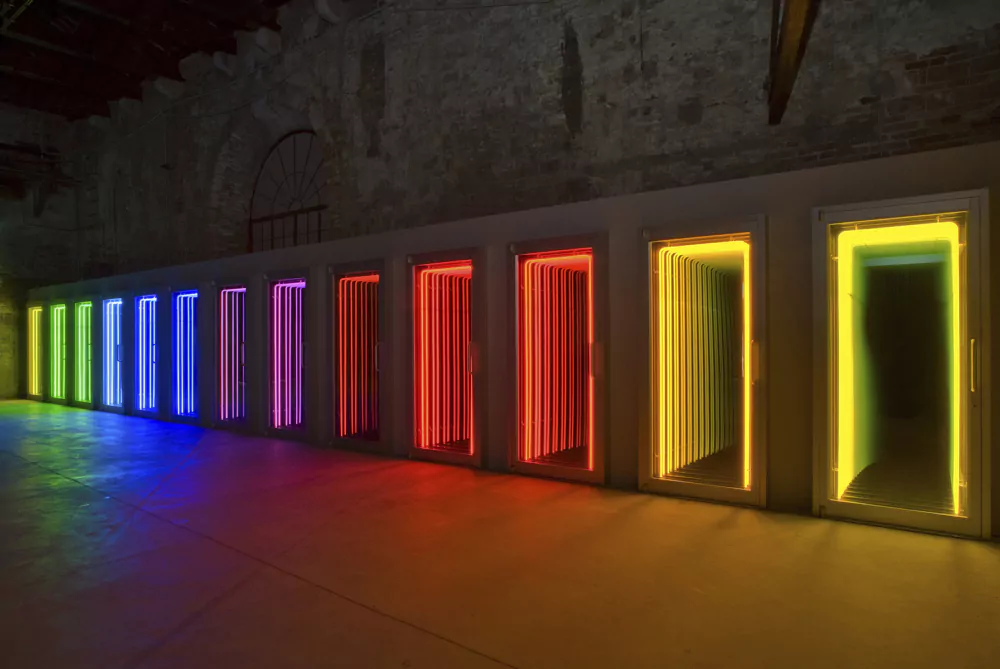
Iván Navarro: This Land Is Your Land
Essay
Art historian Anna Maria Guasch looks at critical appropriation, translation as an act of resistance, and the theory of displacement at work in Iván Navarro’s This Land is your Land, now installed in Art-OMI Sculpture and Architecture Park.
One of the constants running through the work of the New York-based Chilean artist Iván Navarro is appropriation, a critical appropriation that not only involves a radicalization of the resources of quotation or allusion (Navarro’s work is full of allusions to other essential artists in modern art coming from the United States, from Frank Stella to Dan Flavin, passing through Bruce Nauman and Jenny Holzer), but which also implies a constant attitude of revision, of rereading the given, of awareness of the systems in which the art work is exhibited and received, as well as its relationship to the institutional context and to the historical discourse that determines the artist.
But in Navarro’s creative processes, this “appropriation” makes sense only from a certain theory of “displacement” or “distancing”. Nothing is what it seems. The neon lights are not minimalist, they do not obey a procedural aesthetic, nor do their geometric structures follow the dictum of “all that you see is all that there is.” For Navarro, displacement is that which frees him from abstract formalism and makes his works take on the value of spatial metaphors that seek to express the relationship between power and knowledge. We would venture to claim that, just as the pseudo-abstract work of Peter Halley can be understood only from Foucauldian theories of surveillance and punishment, Iván Navarro’s light sculptures and installations should be understood from the perspective of the epic theatre of Brecht and, specifically, from the dramatist’s strategy of displacement (also adopted by other contemporary artists, such as Krzysztof Wodiczko in his public installations). Hence Navarro’s works demand a radical modification of the usual perception of them. Both in Wodiczcko’s public works and in Navarro’s, the viewer remains insecure in the face of the naturalness of the new “body” they are presented with. The normal form of reception is interrupted.

This Land is Your Land, 2014-2020 – at Art Omi Sculpture Park, Ghent, NY, USA
Just as in Brecht’s epic theatre, where the dramatist questions a process centered on the spectator’s emotivity by means of the “distancing” or “alienation” effect – distancing spectators from the drama they are watching and projecting onto them a worldview and a vision of ideological life (Weltanschauung) – so too Navarro’s work distances itself from complacent aesthetics and projects onto us a “memory effect” in which the personal is superimposed on the collective, historical, and social…

A good example of this is the work This Land is Your Land, a public installation initially conceived for Madison Square Park in New York in 2014 (and later shown in numerous places, including Dallas, North Carolina, Chicago, Busan, Seoul, and Arkansas). The three water towers (inspired by the water towers that are characteristic of the New York landscape) that make up the work and the neon texts inside them could be explained by the title of the Woody Guthrie folk song, inspired by the 1940 musical Hobo and its allusion to the nomadic workers of the America of the Great Depression. A song conceived as a response to Irving Berlin’s God Bless America, which Guthrie considered to be “unrealistic and self-indulgent”.
According to Manuel Cirauqui, the curator of the Una guerra silenciosa e imposible (2015) – Navarro’s first retrospective exhibition in his native Chile – the artist’s work flees the “unrealistic and self-indulgent” and, specifically, “the space of art and the artistic institution, in order to refer to a conflictive context, a desire to fight against the institution, against the architectonic space, and against the alienation of the city.” Good examples of this are works such as Death Row (2006-2009), in which the artist gives political significance to the abstract work of Ellsworth Kelly (Spectrum V) by projecting it onto a death row of a prison in the United States, and Reja CorpArtes, a site-specific installation work that diverts the bars from their minimalist origin to investigate questions of control, discipline, and punishment, thereby altering crucial elements and changing the original direction.

Death Row, 2006-2009. Chilean Pavillion, Venice Biennale 2009
In this sense, This Land is Your Land again invokes “displacement theory”, as it resituates the cold and geometric architecture of old models of industrial architecture (with a new formal reference to the photographic series of the German husband-and-wife team Bernd and Hilla Becher) and projects it at a social, political, and also autobiographical level: that of the citizen who was born in 1972 in the final years of the Salvador Allende government – just months before Augusto Pinochet’s military coup d’état – to continue with the citizen who arrived in New York in 1997 seeking connections between Chilean protest music (“the history of music in Latin America is much more interesting than the history of the visual arts”, Iván Navarro has claimed) and the American folk music of Bob Dylan, Joan Baez, and Woody Guthrie.
In his constant reframing of processes, it is clear that Iván Navarro approaches one of the turns that best explains the behavior of an important series of contemporary artists: the turn of “translation”, a translation contemplated as an instrument to create spaces of transversal understanding between different media and between diverse cultures. And always understanding the notion of “translation” as an act of resistance to reading and to the materiality of the language considered – in the words of Emily Apter (The Translation Zone: A New Comparative Literature [2013]) as a form of “listening-thinking” or of “reading-thinking”. In this sense, along with artists such as Alfredo Jaar and the already mentioned Wodiczcko, Navarro is an example of an artist who takes advantage of the concept of translation to nurture a discursive context around questions inherent to our global context: diaspora, migration, exile, colonization of the other.
An other who is fixed by the use of words inside these cylindrical towers and by the resource of the neon lights and the mirrors that generate optical illusions, infinite reflections, and a sense of abysm, and which proclaim an almost utopian desire to journey towards the unknown and, at the same time, give voice and life to the inert object. Words, lights, and mirrors that burst into the public space with freedom and eloquence, endowing it with a verbality beyond the silence of sculpture and monuments.
And always understanding
the notion of “translation”
as an act of resistance to reading
and to the materiality of the language
A dialogue without sound or argumentative phrases, with only words, words of light that seem to give voice to those who have none (such as these wandering migrants in search of work in a promised land) and which trace a discursive line beyond any official and hegemonic rhetoric. Navarro likes to use short words – such as Me/We, Open/Ended, Bed, Bomb – which, thanks to the reflecting mirrors, multiply and function as wounds, reverberations, or echoes in the public space, providing a citizen’s dialogue that can activate public reflection and question the discourse of power. Specifically with the water tanks of This Land is Your Land, Navarro uses three words: Me and We in the first, Bed in the second, and the image of a ladder in the third.
It is when ME – the “I” of the artist – becomes the WE of society (“There’s never a ‘me’ without a ‘we’,” argues Navarro). It is when the BED, which alludes to the idea of a habitable and corporeal space, as well as to the poetics between home and origin, transcends the limits of the human body to open itself to the world of the infinity of emptiness. An almost metaphysical emptiness, which accounts for the ladder in the third tank, a symbol of endless growth. And all from superimposing meanings that go beyond the aesthetic and artistic and even beyond the autobiographical. Navarro reclaims everyday objects, explores electricity with aesthetic and political aims, and makes use of words without renouncing a certain aesthetics of the spectacle or of education in speaking to the spectator but at the same time questioning the spheres of power.
In the contemporary global context, there are a number of artists – and Iván Navarro is among them – who act as historical agents of memory in contraposition to amnesia and destruction, that is to say, who seek acts of remembrance. And This Land is Your Land effectively functions as an “act of remembrance”, both individual and collective, understanding memory from an interdisciplinary perspective.
‘This Land is Land’, Art-OMI Sculpture & Architecture Park, Ghent, NY (USA), until 2024.
ANNA MARIA GUASCH is a Professor of Art History at the University of Barcelona (Spain), art critic and curator. She has published several books such as The Codes of the Global (2018), The Turns of the Global (2019) and Derives. Critical Essays on Contemporary Art (2022).
